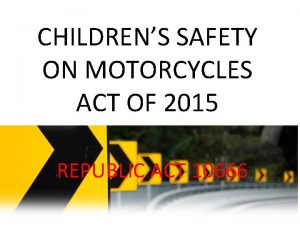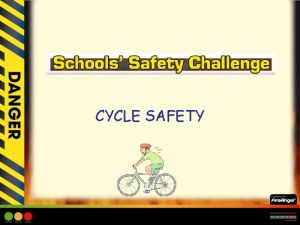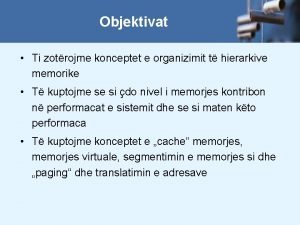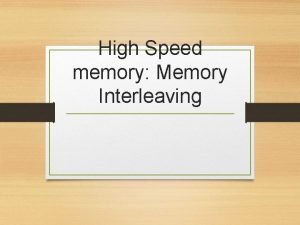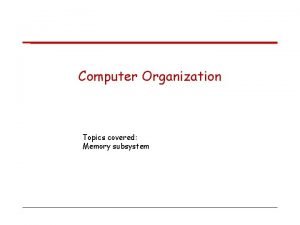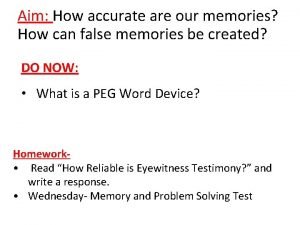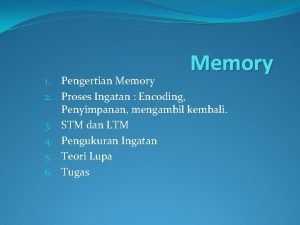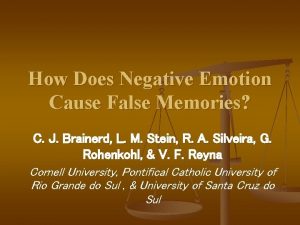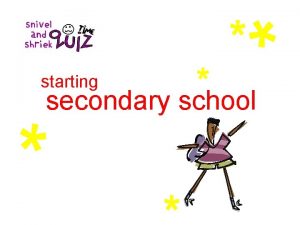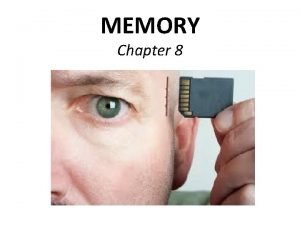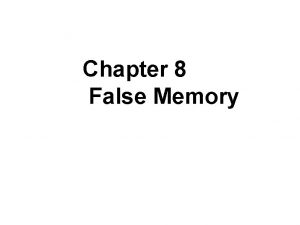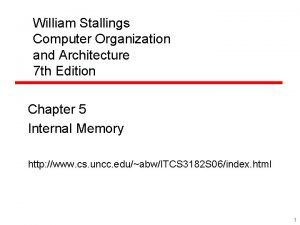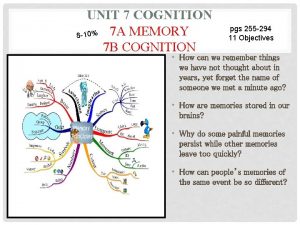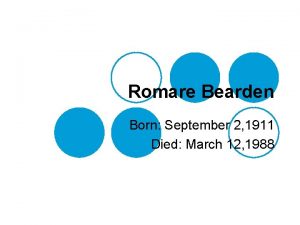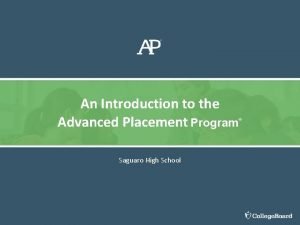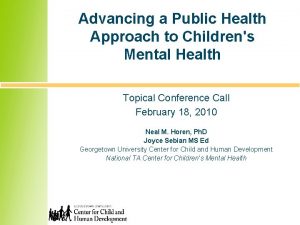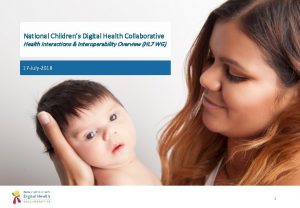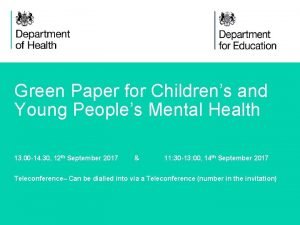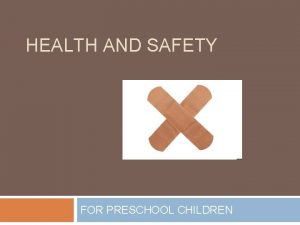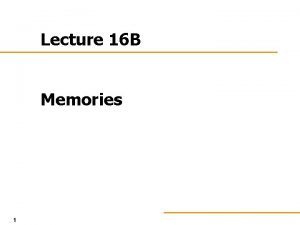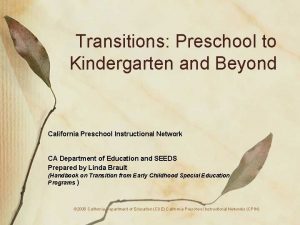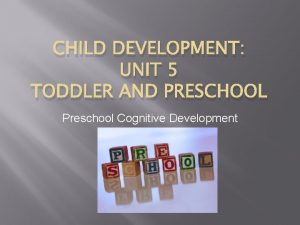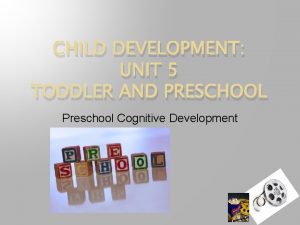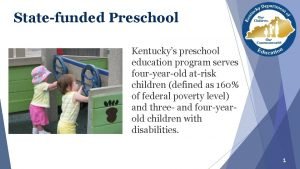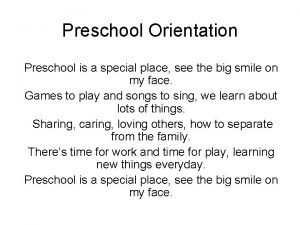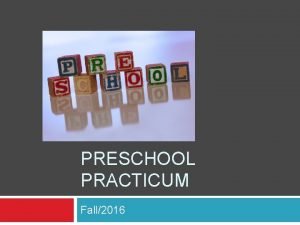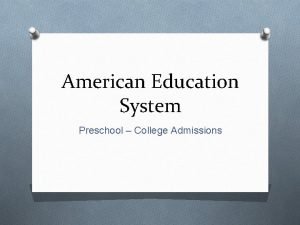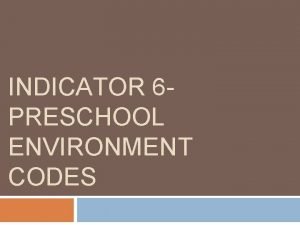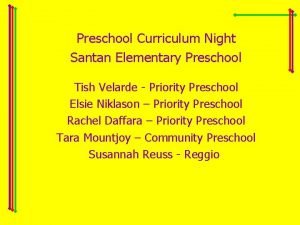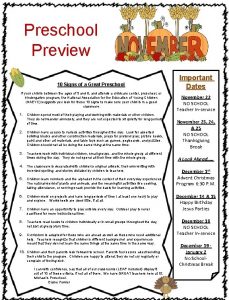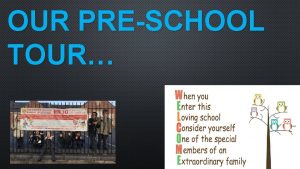HEALTH AND SAFETY FOR PRESCHOOL CHILDREN MEALTIME MEMORIES











































- Slides: 43

HEALTH AND SAFETY FOR PRESCHOOL CHILDREN

MEALTIME MEMORIES: • Share mealtime memories you have from childhood. • What values and customs help shaper routines and interactions? • What memories do you have that created negative attitudes toward certain foods? • What positive attitudes do you have towards certain foods because of an experience?

NUTRITION EDUCATION: • Help children learn to eat a variety of foods. • Increase children’s awareness of reasons for selecting certain foods. – They often prefer sweet, salty, processed foods • Help children develop positive attitudes about food.

INTRODUCING NEW FOODS: 1. 2. 3. 4. 5. 6. 7. Introduce only one new food at a time. Serve new food with familiar foods. Serve small amounts. Introduce new food only when child is hungry. Talk about the taste, texture, etc. Do not force child to eat, try again later. Be a model!

FOOD ALLERGIES: • Document any food allergies of children. • Post notice to all employees of food allergies.

COOKING EXPERIENCES: • • • Being involved encourages tasting. Preparing a final product builds self esteem. Cook only nutritious foods. Let the children do the cooking. Plan for children’s safety.

COOKING HYGIENE: Spray all surfaces with chlorine bleach solution before and after all food experiences. Leave 15 seconds. Be attentive to cleanliness. –Hand washing –Wear rubber gloves –Table and utensil cleanliness

Washing Your Hands • • • For 20 seconds. Sing through the alphabet. After using the restroom. After sneezing or coughing. After touching face or hair. Before and after handling ANY food, but especially raw meat, poultry, or eggs.

INTREGRATE FOOD INTO OTHER AREAS: • SCIENCE: Melting, congealing, shrinking, expanding, water to steam. • LANGUAGE: Learn cooking vocabulary, names of foods and utensils. • MATH: Measuring, compare quantities. • SOCIAL STUDIES: Working cooperatively, learn about cultures & customs. • LITERACY: Read recipes from chart, make grocery lists, read stories connected to the food.

SNACK GUIDELINES: 1. Snack must be nutritious (very little sugar). 2. Creative and reflect theme. 3. Preplanned and ingredients listed on weekly grocery list. 4. Include a nutritious drink daily. Which? 5. Economical, seasonal. 6. Appealing to children.

SNACK GUIDELINES: cont’d • Should children be allowed to select snack from several different items? • If one choice is available, should they be given something else if they don’t like it? • Should children be allowed to eat as much as they like? • Could all schools follow these guidelines?

WHAT CAN FOODS TEACH? Where food comes from Cultures Color Texture Taste, smell, sound Safety Big & Little Sequence Keeping time Counting Liquid/Solid Team work Shape & size Following directions

WHAT ABOUT MANNERS? • “Please, Thank you, Your welcome, Excuse me”. • Sharing • Appropriate eating habits

CREATIVE IDEAS:

CREATIVE IDEAS: cont’d

CHOKING CAUTION: • Which foods cause choking? • Avoid raw carrots, peanuts, hard candy, raisins, popcorn, bite size pieces that can be swallowed without chewing. What should you do if a child is choking? – Encourage them to cough. – Never pound on the back – Use abdominal thrust as many times as needed

CHILDHOOD SAFETY: • THE LEADING CAUSE OF DEATH AMONG PRESCHOOLERS IS: ACCIDENTS

CHILDHOOD SAFETY: • Safety rules are limits that identify safe behavior. • Environment should be safe for children to explore. – Tell Director of any unsafe conditions. • Outdoor play area should be fenced and cleared of trash. – Toys & equipment should be strong & durable

CHILDHOOD SAFETY: cont’d • First Aid kits escential in child care. • Children are curious therefore we need to be alert in order to prevent accidents. • Have all children visible to you at all times.

POISON SAFETY: • Cleaning supplies should be locked up. • Never store in old food containers. • Keep Poison Control Center phone number next to phone. 581 -2151 – Determine what & how much child ingested. • Mark poison symbol on dangerous items.

FIRE SAFETY: • Children should learn to recognize the danger of fire and treat fire with caution. • Have regular fire drills – A written plan of action – A posted map for evacuation If you saw smoke coming from underneath a closed door what would you do if you were working in child care?

EARTH QUAKES, BOMBS, & INTRUDERS • Earthquake drill: Take cover under desks, tables, or in doorways. Do not leave building. • Bombs: Search area for possible bomb. • Intruders: Lockdown- lock doors, take cover away from doors.

TRAFFIC SAFETY: • Children should learn to stop before crossing the street. – And learn to cross a street safely. • Children should learn to interpret traffic signals. How would you teach that?

WATER SAFETY: • Any form of water play should be carefully supervised. • Children should never be left unsupervised when near a swimming pool, wading pool, or pond How many inches of water does it take to drown a child?

PERSONAL SAFETY: • Define to children what a “Stranger” is. • Do not label children’s clothing or bags with their name. Why? • Teach children about “Safe Touching”. • Instruct children to never give out their name, address or phone number over the internet.

CONFIDENTIALITY & LIABILITY: • Never allow a strange person to pick up child. – What do you do?

HEALTH: • What is the #1 important hygiene practice for children to learn? WASHING HANDS!!!! What is the first thing to do if a child is sick at school? • ISOLATE THEM FROM OTHER CHILDREN. Then notify parents to take child home.

HEALTH: • Establish healthy routines & model healthy choices. • Notify parents of any exposure to a communicable disease. • Medication cannot be given without parent permission. – Must be left in original container. • Keep immunization records of each child on file. –All records are confidential.

SEIZURES/CONVULSIONS: 14. What should you look for in a seizure? Sudden rise in temperature, loss of consciousness, stiff body, held breath, jerking of limbs, loss of bowel control, confusion, drowsiness. 15. Why do seizures occur? Disruption of normal electrical impulse patters of brain. May be spontaneous or set off by poisons, fevers, or infections.

SEIZURES/CONVULSIONS: cont’d 16. How can you help a child who is having a seizure? Do not panic! Lay child in middle of floor on side so tongue doesn’t fall back & block airway. Do not leave child alone, do not force anything in the mouth. When it is over leave child on side and call a doctor.

DROWNING: 17. How much water needs to be present for a child to drown? Two inches is of water is enough to cover an infant’s nose and mouth. 18. If a child is conscious after drowning, what do you do? Cover the child and keep them warm and dry until help arrives. 19. What should you do for a drowned, unconscious child who is breathing? Remove the child from the water & do nothing by wait for help

SHOCK: 21. List several symptoms of shock. Pale, blue-gray skin, rapid weak pulse, shallow fast breathing, cold clammy skin, sweating, dizziness, blurred vision, restlessness, thirst, unconsciousness. 22. How would you prevent loss of body heat in a child suffering from shock? Cover child to prevent loss of body heat but do not overheat. 23. List conditions that can cause shock. Dehydration, , reactions to insect bites and medications, burns, electric shock, heart trouble, severe bleeding, infection. 24. What do you do to treat a child in shock. Direct pressure to bleeding, raise legs above heart, loosen tight clothing, turn head to one side, keep warm, stay calm.

POISONING: 25. List the symptoms of poisoning. Vomiting, diarrhea, burns on mouth, convulsions. 26. What first aid item induces vomiting? Syrup of Ipecac. 27. What type of poisons should not be thrownup? Corrosive poisons such as acids, beach, lye or weed killer. 28. What is the telephone number of Poison Control Center? 1 -800 -456 -7707, SLC 581 -2151

HEAD INJURY: 29. What kind of accidents can cause serious head injuries? Being hit by baseball, falling off a bicycle or skateboard, falling from window, Auto accidents. 30. How should you diagnose a serious head injury? Discharge of blood from nose or ears, vomiting more than once, headache, irritability, drowsiness, stunned or dazed.

BLEEDING: 31. How can a caregiver control the flow of blood from a child’s wound? Direct pressure, elevate the arm or leg above the heart. 32. If there is an object stuck in the child’s flesh, what do you do to control the bleeding? Apply pressure above and below the object, not directly on the object itself. Do not remove the object.

BROKEN BONES: 33. Explain the three different types of fractures. Simple fracture: Broken in one place. Compound fracture: Broken in 2 or more places. Greenstick fracture: Bones bend like a tree limb. 34. What are the symptoms of a fracture? Pain, swelling, bruising, possible deformation, being unable to move without pain.

BURNS: 35. Describe how to treat a first-degree burn. With a cool compress or cold water. While painful, seldom needs the attention Of a doctor. 36. Describe how to identify a second-degree burn and how to treat it. As first degree gets worse, it turns into second degree. Painful, but can result in loss of fluid. If burn is larger than a hand, they should be seen by a doctor. Second Degree burns must be seen by a doctor. 37. What should you teach a child to do if their clothing catches fire? Stop, drop, roll.

Classification and Treatment First Degree: Most first degree burns are superficial and can be cared for at home without the help of a medical professional. These burns are much like typical sunburns and are cared for in a similar way. You should immerse the burn in cool water (do not use ice!) and then blot it gently and apply burn cream and then cover with a dry, clean, non-stick pad. These burns usually leave the skin red and mildly swollen. The skin sensations are intact and the burn is painful to the touch. Most average sunburns are characterized as first degree burns.

*Second Degree: Second degree burns are more serious and should be seen by a medical professional. If the burn seems very severe report to an emergency room or call 911. Although second degree burns often look like first degree burns, in the sense that they are red, the damage goes deeper. With these burns, the pain is more intense and blistering may occur. The burns may also be wet, or weeping and may have a shiny surface. It is advised that these burns are not touched or covered.

*Third Degree: These burns are the most serious. Third degree burns are very deep and the burn often appears white, deep red, or black because of skin death. These burns are often without sensation because nerve endings have been damaged. It is important that these burns are not touched, or covered unless absolutely necessary. Any contact with the burned skin cause more damage and heighten the chance of infection.

BURNS: cont’d 38. If the child begins running when clothing is on fire, what Should you do? Use a bucket of water or smother flames with nonflammable materials. Lie on top and roll with the child to smother the flames. 39. What items should not be used on burns? Butter, cream, ointment, chicken skin or other home remedies.

EYE INJURY: 40. What steps should you take if a child complains o something, like sand, in the eye? Small speck of dust is not serious. The eye will naturally wash itself out with tears if given time. 41. What should you do for a foreign body embedded in the eye? How might you remove a foreign body from the eye if it is not embedded? Do not try to remove it. Cover eye with clean clothe and tape in place. Take child to ER. If object is not embedded, pour a glass of water across the open eye and ask child to look up while you remove object with corner of handkerchief.

 Mealtime matters
Mealtime matters Spacing effect ap psychology
Spacing effect ap psychology Children’s safety on motorcycles act of 2015?
Children’s safety on motorcycles act of 2015? Cycle safety for children
Cycle safety for children Semiconductor ram memories
Semiconductor ram memories Introduction to the giver
Introduction to the giver Take out a piece of paper
Take out a piece of paper Irvine valley memories
Irvine valley memories Memory in digital electronics
Memory in digital electronics Implicit explicit memory
Implicit explicit memory The man he esteemed most in calamba.
The man he esteemed most in calamba. How to preserve personal memories
How to preserve personal memories Shadow memories of space
Shadow memories of space Hierarkia e memories
Hierarkia e memories Memory interleaving diagram
Memory interleaving diagram Confedency
Confedency Semiconductor ram memories in computer organization
Semiconductor ram memories in computer organization Repressed memories
Repressed memories How accurate are our memories
How accurate are our memories Perbedaan stm dan ltm
Perbedaan stm dan ltm How does negative emotion cause false memories
How does negative emotion cause false memories I like school by lenore hetrick
I like school by lenore hetrick Memories q
Memories q N the zone sports photography
N the zone sports photography Memories definition
Memories definition False memories chapter 8
False memories chapter 8 Year 6 leavers poem for parents
Year 6 leavers poem for parents Advanced dram organization
Advanced dram organization Memories (2013)
Memories (2013) Ram types comparison
Ram types comparison What effortful processing methods aid in forming memories?
What effortful processing methods aid in forming memories? Romare bearden born
Romare bearden born Memories factory
Memories factory Light bulb memories
Light bulb memories Saguaro infant care and preschool
Saguaro infant care and preschool Existanxe
Existanxe National health programme for children in india
National health programme for children in india Children's mental health
Children's mental health National children's digital health collaborative
National children's digital health collaborative Green paper children's mental health
Green paper children's mental health Kontinuitetshantering
Kontinuitetshantering Novell typiska drag
Novell typiska drag Tack för att ni lyssnade bild
Tack för att ni lyssnade bild Returpilarna
Returpilarna


